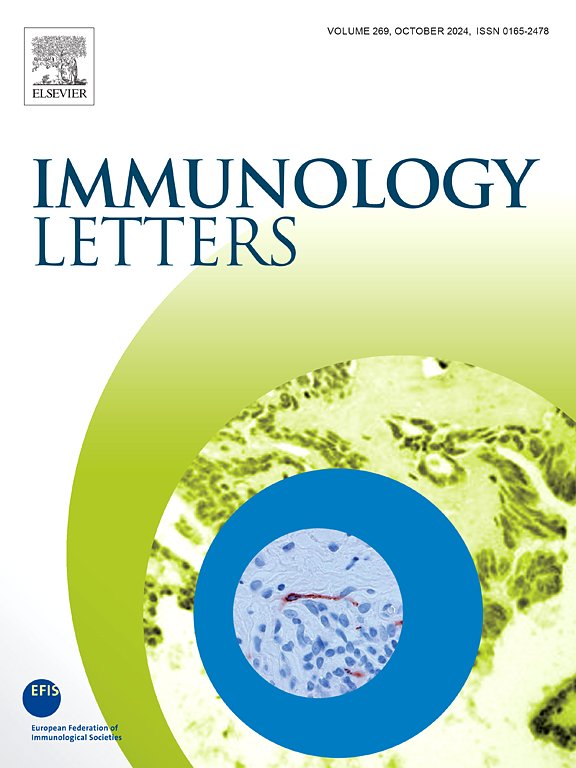net激活AIM2介导滑膜成纤维细胞焦亡,促进急性痛风性关节炎的发展
IF 2.8
4区 医学
Q3 IMMUNOLOGY
引用次数: 0
摘要
急性痛风性关节炎是一种以高尿酸血症为特征的代谢性疾病,急性发作涉及中性粒细胞释放的NETs通过其主要成分DNA激活免疫反应,作为危险相关分子模式(DAMPs)。目的探讨痛风性关节炎急性发作时,NETs DNA是否激活滑膜成纤维细胞AIM2炎性小体,诱导热亡,加重炎症。方法建立急性痛风性关节炎AIM2基因敲低小鼠模型,H&;E染色观察关节病理变化,流式细胞术分选滑膜成纤维细胞和中性粒细胞,Western blot检测AIM2、Caspase-1和GSDMD相关蛋白的表达。采用ELISA法检测血清和细胞上清中TNF-α、IL-6、IL-1β和IL-18的水平。用尿酸盐诱导中性粒细胞释放NETs,用免疫荧光(Cit-H3、PAD4)和ELISA检测NETs标记物(dsDNA、MPO-DNA、NE-DNA)。NETs培养基与滑膜成纤维细胞共培养,CCK8和刮刮法检测细胞活性和迁移,免疫荧光法检测滑膜炎标志物(Thy1、VCAM-1、PDPN), TUNEL法和LDH释放法检测细胞焦亡。通过沉默或过表达AIM2基因、Western blot和ELISA方法,研究AIM2在NETs诱导的焦死和炎症反应中的作用。结果aim2基因敲低可显著缓解msu诱导的小鼠急性痛风性关节炎的症状,减轻关节肿胀和病理损伤。炎性因子(TNF-α、IL-6、IL-1β、IL-18)和裂解型Caspase-1/Caspase-1、GSDMD- nt /GSDMD)表达水平降低。结果发现,中性粒细胞在尿酸钠刺激下释放NETs,表现为Cit-H3和PAD4显著上调,dsDNA、MPO-DNA和NE-DNA复合物增加。NETs可诱导滑膜成纤维细胞的炎症反应,表现为细胞活性和迁移能力下降,炎症因子释放增加,滑膜炎标志物(Thy1、VCAM-1、PDPN)显著升高。此外,NETs通过激活AIM2炎症诱导滑膜成纤维细胞焦死,加重炎症反应,而AIM2基因下调可有效抑制NETs诱导的焦死和炎症反应,提示NETs通过AIM2介导的滑膜成纤维细胞焦死,在痛风关节炎的发生发展中发挥关键作用。结论nets激活的aim2介导的滑膜成纤维细胞焦亡在急性痛风性关节炎中起重要作用,为急性痛风性关节炎提供了新的治疗靶点。本文章由计算机程序翻译,如有差异,请以英文原文为准。
NETs activate AIM2 to mediate synovial fibroblast pyroptosis and promote acute gouty arthritis development
Background
Acute gouty arthritis is a metabolic disease characterized by hyperuricemia, with acute attacks involving neutrophil-released NETs activating immune responses through their major component, DNA, as danger-associated molecular patterns (DAMPs).
Objective
To investigate whether DNA from NETs activates the AIM2 inflammasome in synovial fibroblasts during acute gouty arthritis attacks, inducing pyroptosis and exacerbating inflammation.
Methods
The AIM2 gene knockdown mouse model of acute gouty arthritis was constructed, the joint pathological changes were observed by H&E staining, the synovium fibroblasts and neutrophils were sorted by flow cytometry, and the expressions of AIM2, Caspase-1 and GSDMD related proteins were detected by Western blot. The levels of TNF-α, IL-6, IL-1β and IL-18 in serum and cell supernatant were detected by ELISA. Neutrophils were induced to release NETs by urate, and NETs markers (dsDNA, MPO-DNA, NE-DNA) were detected by immunofluorescence (Cit-H3, PAD4) and ELISA. NETs media were co-cultured with synovial fibroblasts, cell activity and migration were evaluated by CCK8 and scrape assay, markers of synovitis (Thy1, VCAM-1, PDPN) were detected by immunofluorescence, and pyroptosis was evaluated by TUNEL and LDH release. By silencing or overexpression of AIM2 gene, Western blot and ELISA, the role of AIM2 in NETs induced pyrodeath and inflammatory response was investigated.
Results
AIM2 gene knockdown significantly alleviated the symptoms of MSU-induced acute gouty arthritis in mice, reducing joint swelling and pathological damage. Expression levels of inflammatory factors (TNF-α, IL-6, IL-1β, IL-18) and cleaved Caspase-1/Caspase-1, GSDMD-NT/GSDMD) were decreased. It was found that neutrophils released NETs in response to sodium urate stimulation, manifested by significant upregulation of Cit-H3 and PAD4, as well as increased dsDNA, MPO-DNA, and NE-DNA complexes. NETs can induce inflammatory response in synovial fibroblasts, which is manifested as decreased cell activity and migration ability, increased release of inflammatory factors, and significantly increased markers of synovitis (Thy1, VCAM-1, PDPN). In addition, NETs induce scorch death of synovium fibroblasts by activating AIM2 inflammatories, which aggravates the inflammatory response, and AIM2 gene knockdown can effectively inhibit the scorch death and inflammatory response induced by NETs, indicating that NETs play a key role in the occurrence and development of gout arthritis through AIM2-mediated scorch death of synovium fibroblasts.
Conclusion
NETs-activated AIM2-mediated synovial fibroblast pyroptosis plays a crucial role in acute gouty arthritis, providing a new therapeutic target.
求助全文
通过发布文献求助,成功后即可免费获取论文全文。
去求助
来源期刊

Immunology letters
医学-免疫学
CiteScore
7.60
自引率
0.00%
发文量
86
审稿时长
44 days
期刊介绍:
Immunology Letters provides a vehicle for the speedy publication of experimental papers, (mini)Reviews and Letters to the Editor addressing all aspects of molecular and cellular immunology. The essential criteria for publication will be clarity, experimental soundness and novelty. Results contradictory to current accepted thinking or ideas divergent from actual dogmas will be considered for publication provided that they are based on solid experimental findings.
Preference will be given to papers of immediate importance to other investigators, either by their experimental data, new ideas or new methodology. Scientific correspondence to the Editor-in-Chief related to the published papers may also be accepted provided that they are short and scientifically relevant to the papers mentioned, in order to provide a continuing forum for discussion.
 求助内容:
求助内容: 应助结果提醒方式:
应助结果提醒方式:


